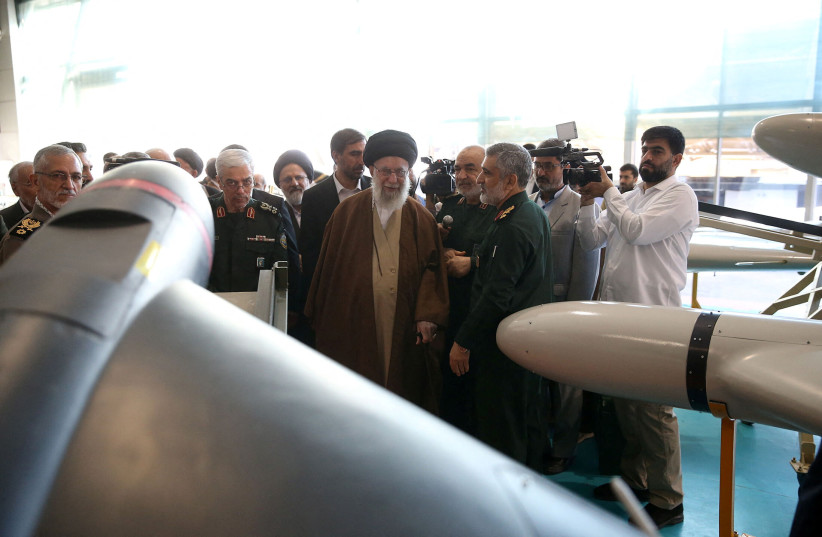After surprise Tel Aviv attack, Houthi drone arsenal comes under spotlight – analysis
The Iranian-backed Houthis have been using drones for about a decade and began using them during the ongoing civil war in Yemen. When Saudi Arabia intervened in Yemen to attempt to prevent the Houthis from taking over Aden and other key parts of the country in 2015, the Iranian backing for the Houthis increased in reaction. The Iranian support of the Houthis helped the militia develop a large arsenal of drones.
The Houthis chose to develop drones because this was a cheap way to create a kind of instant air force. The Houthis don’t have very limited resources, and their power comes from their relatively impoverished supporters located in the mountains of Yemen. They essentially have no real air power.
With Iranian support, however, the Shiite militia built an impressive arsenal of missiles and drones. They used these to terrorize Saudi Arabia from 2015 onwards. For instance, They used kamikaze drones to attack air defense radars.
The first Houthi drones were simple, and the Houthis soon invested in kamikaze drones based on the Iranian Ababil family. The Qasef-1 was the first important Houthi kamikaze drone. By July 2019, the Houthis had developed at least eight types of drones. These were put on display at an event.
They included the Qasef-1 and its successor, the Qasef-2K. They also included several drones from the Sammad family, including the Sammad-1, 2, and 3. They also have drones called the Hudhud, Raqib, and Rased.

To get an idea of the size and capabilities of these drones, let’s take a look at a few of them. For our purposes, the Houthi surveillance drones, such as the Hudhud, Raqeed, and Rased, do not matter that much. They are small and don’t have a long range. They can fly up to twenty miles and have a length of several feet.
Houthi drone types and capabilities
The Qasef had an initial range of around 100 miles and was about ten feet long. It also had a ten-foot wingspan. With its warhead, the kamikaze drone weighs up to 200lbs and flies at a speed of around 200 miles per hour. The Qasef has a strange design, with long wings at the back and short wings in the front. In this respect, it has some similarities to a cheap cruise missile.
The Qasef series of drones was soon bolstered by the Sammad series, which looks like a type of large model airplane. They have a simple, long rectangular wing and a fuselage that looks like a long tube. They can carry a warhead in the fuselage and be used as kamikaze drones. They have a V-shaped tail. This kind of design for a drone is one that the Houthis likely borrowed by looking at other drone designs, such as Israel’s Hermes-450.
The Sammad range was increased over time to more than 1,000 miles. The Sammad drones are not that heavy, usually not exceeding 100lbs in weight. Their warhead might be around twenty to forty pounds of explosive. These specifications can likely be changed to squeeze out a more extended range.
In late 2020, the Houthis also acquired the Iranian Shahed 136 drone. This is a delta-wing-shaped drone, basically a flying triangle. It is a kamikaze drone. It is not very large, about ten feet long, weighing around 400lbs.
Fabian Hinz, an expert at the International Institute for Strategic Studies, posted a thread on X that discussed what type of drone might have been used in the attack on Tel Aviv. He identified it as probably a Sammad drone. In a photo of the engine of the drone he noted: “the one thing I find notable is the use of a Mado 275 engine. Most Sammads I have seen seemed to use the less powerful DLE 170.”
The type of engine is important because it can, in many cases, be traced back to the manufacturer. In the past, Iran has sought to acquire engines from Europe or China. Recently, a Hezbollah supporter was detained in Germany for seeking to acquire drone parts, including engines, to be sent to Hezbollah in Lebanon.
The Houthi drone arsenal is impressive. Its drones have terrorized shipping, and their range appears to be expanding. However, the drones don’t have large warheads, and the amount of destruction they can cause has been limited so far. Nevertheless, they are still highly deadly weapons that can be programmed for precision strikes on various targets, making them very dangerous.
The Houthis have developed this arsenal of drones with crucial Iranian help. The Houthis should be expected to continue to expand their drone arsenal, a reality also true of Hezbollah in Lebanon. All the Iranian proxies use similar drone designs and drone families, from the Shahed delta-wing types to the more simple tube-shaped body of the Sammad.
The Houthis and Hezbollah claim they are building drones with more sleek, stealthy designs and capabilities. They may also try to alter the engines to more quiet electric ones. However, they will always face issues relating to energy supply for the engine and the issue of range, size, and weight.





Comments are closed.